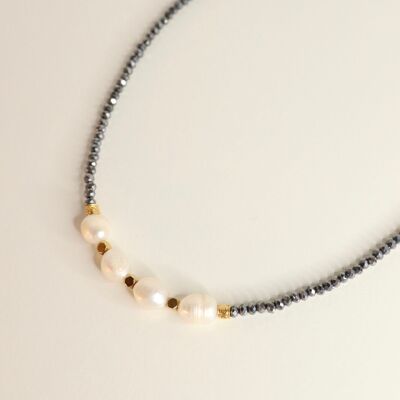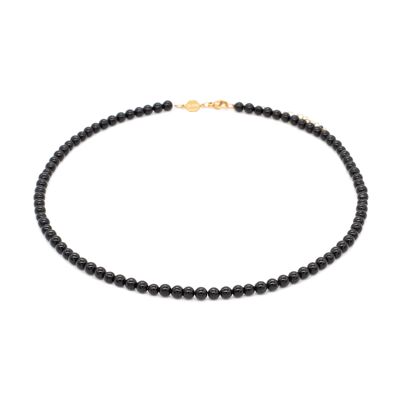


<h3 class="p1"><b>Rowena necklace, in black onyx, hematites and crystallized shungites</b></h3> <p class="p1">The <strong>Rowena</strong> necklace, in black onyx, hematites and crystallized shungites, is named after the legendary witch Rowena, embodying mystery and strength. Its dark hues are enhanced by gray and golden hematites, as well as 24K fine gold-plated spacers (1 micron), revealing a captivating and bewitching power.</p> <p class="p1">To be worn alone or in accumulation with the <i>Elza</i> necklace in the same tones. </p> <h4 class="p1"><b>Features:</b></h4> <ul class="ul1"> <li class="li2"> <span class="s1"></span><b>Materials used:</b>Black onyx, hematites, shungites</li> <li class="li2"> <span class="s1"></span><b>French manufacturing:</b> handmade by Soélia Bijoux</li> <li class="li2"> <span class="s1"></span><b>Components and findings:</b> gold-plated chain, 3 micron gold-plated clasp and components gilded with 24 carat fine gold 1 micron</li> <li class="li2"> <span class="s1"></span><b>Necklace size:</b>35 cm</li> <li class="li2"> <span class="s1"></span><b>Extension chain included:</b> 7 cm (can be extended on request, free service)</li> <li class="li2"> <span class="s1"></span><b>Style</b>: Rock chic, Chic, Hippie chic to wear alone or in accumulation</li> </ul> <h4 class="p1"><b>Black onyx</b></h4> <p class="p1">Black onyx, taken since Antiquity, takes its name from the Greek <i>onux</i> ("nail") and is said to have been created from a nail of the goddess Venus according to mythology. The Egyptians and medieval civilizations used it to repel negative energies. In India and China, this stone is said to be recognized for its powers of protection and stability. Today, black onyx embodies elegance and resilience in jewelry, a symbol of strength and timeless anchoring. </p> <h4 class="p2"><b>Hematite</b></h4> <p class="p2">Hematite, used since Antiquity, owes its Greek name <i>haima</i> ("blood") to the red color of its powder. The Egyptians and Romans considered it protective and used it in amulets for bravery. In the Middle Ages, it was taken for its supposed medicinal virtues. Today, hematite is appreciated in lithotherapy for its supposed stabilizing effects and in jewelry for its metallic shine. </p> <h4 class="p2"><b>Shungite</b></h4> <p class="p2">Shungite is a rare and enigmatic stone, originating mainly from the Karelia region of Russia, where it has been mined for centuries. Composed almost entirely of carbon, it is unique because of its fullerenes (carbon molecules with exceptional properties), which are only found naturally in this stone. In Russia, shungite has been used since the 18th century, for its purifying properties, particularly for filtering water. In lithotherapy, shungite is attributed with protective and purifying properties. </p> <h4 class="p1"><b>Additional details:</b></h4> <p class="p1"><i>The stones and pearls used are natural or semi-precious, thus offering subtle variations in color that make each piece of jewelry unique.</i></p>
































